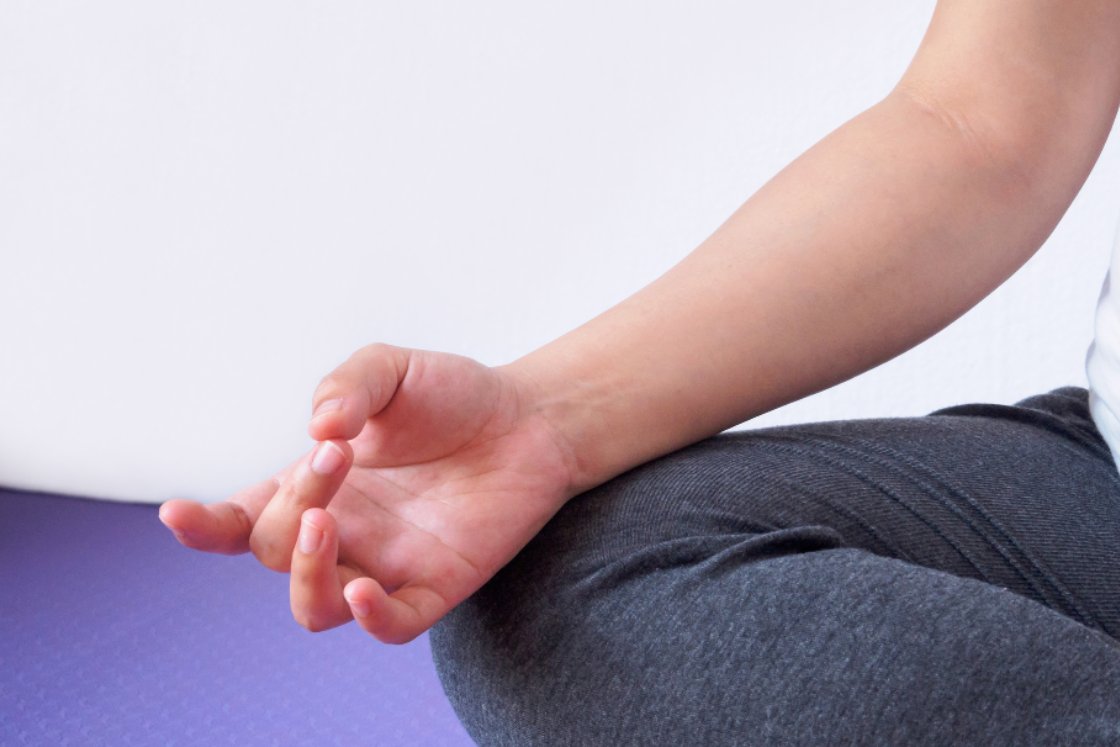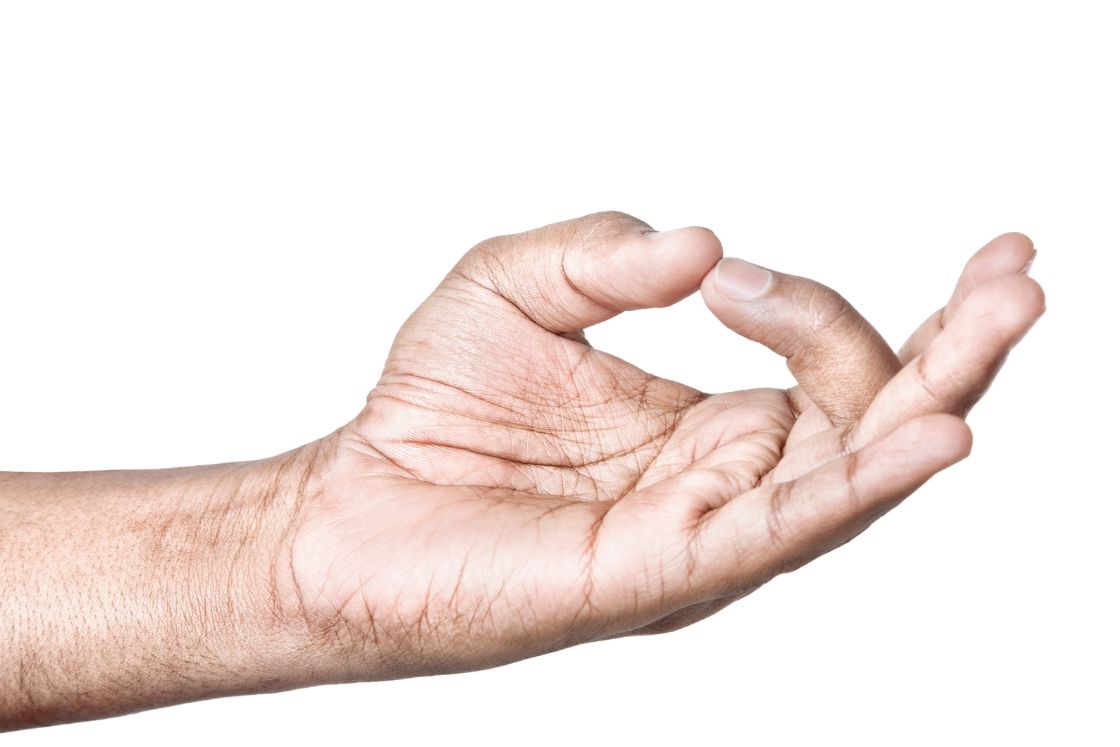
Akash Mudra, also known as Akasha Vardhak Mudra (where “Vardhak” in Sanskrit means “to increase”), is a fundamental hand gesture in yoga and Ayurveda. This powerful yet simple hand mudra involves specific finger positioning to stimulate the space element within the body.
It is frequently practiced during meditation and Pranayama breathing exercises to enhance their effectiveness and deepen the practitioner’s spiritual experience.
Meaning of Akash Mudra
In Sanskrit, ‘Akash‘ means ‘space‘ or ‘ether,’ and ‘Mudra‘ means ‘gesture‘ or ‘seal.’ Therefore, Akash Mudra translates to the “Gesture of Space.”
Akash mudra is also known as Shuni Mudra, it symbolizes patience and is used to balance the space element (Akasha) in the body. Akash or space is one of the five essential elements of the body.
Akash mudra involves touching the middle finger, which represents the space element, to the thumb, which represents the fire element. By doing this, Akash Mudra helps address issues related to the space element, such as migraines and hearing loss. It also enhances the body’s space element, promoting mental clarity, detoxification, and heightened awareness.
In addition to physical benefits, Akash Mudra aids in achieving mental peace and balancing the mind and body, thus improving the practitioner’s spiritual well-being.
What ‘Akash’ Means in Akash Mudra?
In the context of Akash Mudra, ‘Akash’ represents the space or ether element that pervades everything. Increasing this element in the body promotes open-mindedness and emotional clarity. It helps transform negative traits such as anger and selfishness into positive qualities like compassion and selflessness.
Practicing Akash Mudra is believed to generate a calming blue energy that activates the Vishuddha Chakra (Throat Chakra). This activation facilitates the connection between individual consciousness (Atma or soul) and universal consciousness (Paramatma or the divine essence), fostering a deeper sense of inner peace and spiritual unity.
How to do Akash Mudra (or Shuni Mudra)

- Sit comfortably in a stable posture like Vajrasana, Sukhasana, or Padmasana.
- Keep your back, neck, and head aligned in a straight line.
- Place the backs of your hands on your knees, with palms facing upward.
- To form the Akash mudra bend the middle finger of each hand and touch it to the tip of the thumb. Basically you make a circle like shape with the middle finger and thumb.
- Extend the other fingers fully and relax them.
- Close your eyes and focus on the space behind them, visualizing it filled with white or yellow light.
- Breathe deeply and slowly, inhaling through your nose and exhaling completely.
- Practice for 10-15 minutes in one sitting.
Idea time and duration
- Ideal Time: Akash Mudra should be practiced in morning time when mind is naturally calm and relaxed. Ideally morning time between 4 am and 6 am is best for optimal results. If this is not possible, you can also practice it in the evening.
- Duration: Aim to practice for 30 to 45 minutes daily. This can be divided into two or three sessions of 10 to 15 minutes each, based on your convenience and schedule.
Precautions
- Individuals with Vata (wind) imbalance should practice Akash Mudra in moderation and care.
- Avoid applying excessive pressure when touching your fingers together. Light contact is sufficient and will prevent discomfort.
- Minimize distractions by avoiding electronic gadgets, tight clothing, and practicing in a well-ventilated space.
- Don’t rush to become an expert. Practice slowly and steadily to avoid exhaustion and ensure gradual improvement.
Akash Mudra is generally safe and beneficial for most people, with no significant side effects reported. As long as it is practiced correctly and with the appropriate precautions, it typically does not cause any adverse effects.
Benefits of Akash Mudra
Akash Mudra offers numerous benefits for both physical and mental health. Practicing this mudra can improve concentration, generates positive energy, support emotional stability, and help maintain a healthy mind-body connection. It is particularly useful for promoting inner peace and enhancing spiritual growth.
Below discussed are some major benefits of this mudra:
1. Supports Respiratory Health: Akash Mudra can help enhance lung function and promote better breathing. This is due to its ability to improve the flow of prana (vital energy) in the body, which supports respiratory health.
2. Alleviates Stress and Anxiety: Practicing Akash Mudra can contribute to a calmer mind and reduced anxiety. By balancing the space element and encouraging mental relaxation, it helps in managing stress effectively.
3. Enhances Mental Clarity: Regular practice of Akash Mudra is associated with improved focus and mental clarity. It helps in sharpening concentration and cognitive function, making it easier to tackle tasks and make decisions.
4. Activates the Throat Chakra: Akash Mudra aids in balancing and activating the throat chakra, which can help address issues related to communication, self-expression, and even physical discomfort in the throat area.
5. Aids in Detoxification: This mudra supports the body’s natural detoxification processes by improving circulation and aiding in the elimination of toxins.
6. Supports Emotional Balance: By calming the mind and promoting inner peace, Akash Mudra helps in achieving emotional stability and resilience.
7. Improves Sleep Quality: Regular practice of this mudra may contribute to better sleep by reducing stress and promoting relaxation.
8. Enhances Spiritual Awareness: Akash Mudra can aid in deepening meditation and spiritual practices by enhancing inner awareness and facilitating a connection with higher consciousness.
While Akash Mudra is widely recognized for its benefits in mental clarity, stress reduction, and spiritual awareness, certain claims about its effects are less substantiated.
Akash Mudra may relief from migraines, reduction of sinusitis pain, or improvement in hearing loss. Additionally, the mudra may not be strongly supported for overcoming calcium deficiency or alleviating neck and shoulder tension.
Conclusion
Akash Mudra offers a range of benefits by balancing the space element in the body. Practicing this mudra can support mental clarity, reduce stress, and promote spiritual growth. You can incorporate this mudra into your meditation routine.





If I have hyper sensitivity to sound, what mudra/mudras should I do to decrease the senstivity.
Can you help me understand the difference between Vayu(air) tattva and Akash(space) tattva? For tinnitus, should I decrease Vayu or Akash tattva?
Hi!
In a meditation I saw a lovely lady that showed me a particular mudra. See, I’m not a yoga practitioner, so I’m finding quite a difficult to finds the meaning.
Looks like the Akash mudra but it was with both hand, one on top of the other, like it was trying to do the infinity symbol ♾️ but most like this 8.
Do you know that mudra?
Kya aakash mudra ka abhyas karne se third eye chakra par dhyan lagta hai? Kya is mudra se parmatma ka shaakshatkar ho sakta hai?kya aakash mudra se dhyan lagta Hain?
I have slightly hyper thyroid one point extra can I practice this mudra. I also have pains morning stiffness in my hand and shoulders. and evern feet pain. Though RA IS NEGATIVE. IS THAT DUE TO THIS HYPER THYROID. BUT I took allopathy medicine for RA FOR ABOUT 2 YRS BUT NOW STARTED WITH AYURVEDA MEDICINE. PLEASE REPLY
Thank you for your great work.
Please how can I tell the difference between akash imbalances. Whether it is high or low?
Thank you.
Actually knowing the symptoms of each of the five elements is what we need to know (and what we learn) in order to work with mudras. When Akash tattva is in excess one may feel detachment from the present situation, emptiness in the body; symptoms include; dry cough, bloating, ear problems, muscular spasms, etc. Low Akash tattva means less space and more structure; which results in weight-gain, tightness, heart problems, varicose veins and stubborn nature. For more information; read this article on Space Element.
Some Authors suggest to practise Akash and Shunya Mudra, one in Morning and the other in the Evening, for Tinnitus. Is it correct?
The leading cause of Tinnitus, according to Ayurveda, is the imbalance of Vata dosha. It implies the imbalance of air (Index finger) and space (middle finger) elements. Shunya mudra and Akash mudra both help balance aggravated Vata dosha by decreasing and increasing the space element. So yes, they can be practised two times separately; one in the morning and one in the evening.
Hi!
Do you know if Akash Mudra is beneficial to overcome some heart ailments, like irregular heartbeat?
I’ve read somewhere that this Mudra mustn’t be practiced while walking… It’s that so?
Yes, akash mudra is beneficial to regulate the heartbeat since it creates space within the chest for the uninterrupted flow of air.
I think there is no such particular rule that it shouldn’t be practised while walking. However, if you’re doing it for meditative purpose, for sure you don’t want to do it while walking. Otherwise, if you’re comfortable in general, then it’s okay.
CAN I DO BOTH AKASH MUDRA AND SHUNYA MUDRA TO IMPROVE HEARING POWER( I AM HAVING HEARING LOSS. CAN I DO THESE MUDRAS IN LYING POSITION BEFORE SLEEPING.
PLEASE REPLY.
REGARDS
GOPAL
Yes, you can do Akash and Shunya mudra (remove numbness) to improve hearing power. However, it’s best suited to do it in a seated cross-legged posture but if you can’t, mudras can be done in the lying position for therapeutic use.